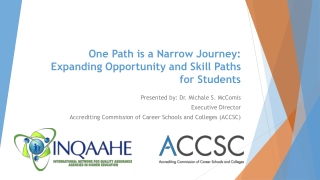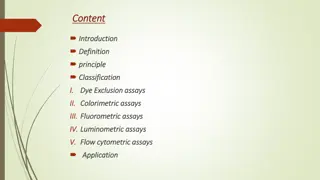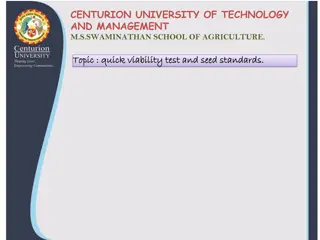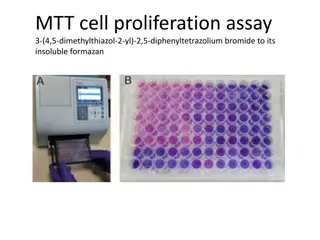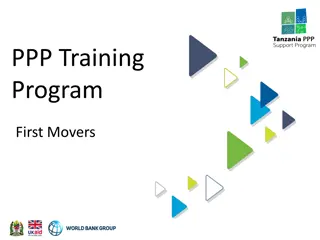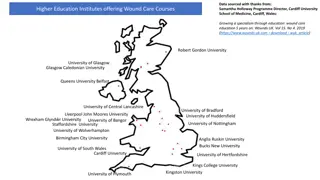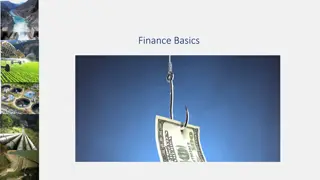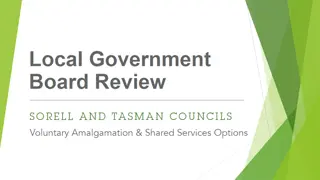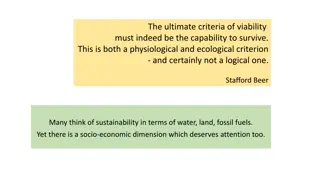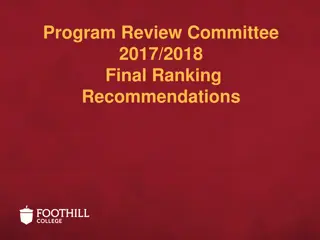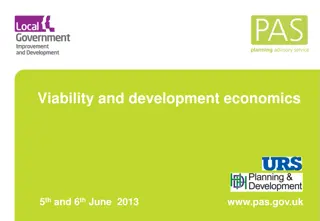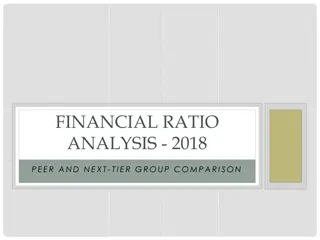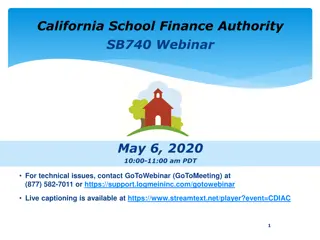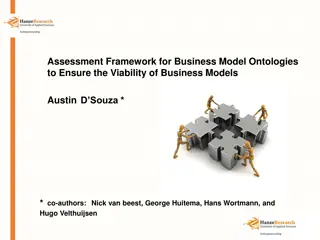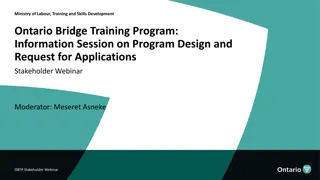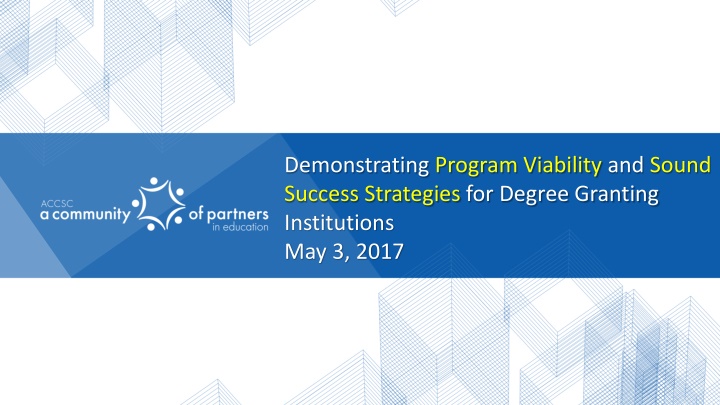
Strategies for Demonstrating Program Viability in Degree Granting Institutions
Explore insightful strategies for ensuring program viability in degree granting institutions, presented by Dr. Julie Basler. Learn about the process of planning and justifying new degree programs, aligning with school missions, and enhancing student benefits.
Download Presentation

Please find below an Image/Link to download the presentation.
The content on the website is provided AS IS for your information and personal use only. It may not be sold, licensed, or shared on other websites without obtaining consent from the author. If you encounter any issues during the download, it is possible that the publisher has removed the file from their server.
You are allowed to download the files provided on this website for personal or commercial use, subject to the condition that they are used lawfully. All files are the property of their respective owners.
The content on the website is provided AS IS for your information and personal use only. It may not be sold, licensed, or shared on other websites without obtaining consent from the author.
E N D
Presentation Transcript
Demonstrating Program Viability and Sound Success Strategies for Degree Granting Institutions May 3, 2017
Presented on behalf of the Program Review Committee Dr. Julie Basler ACCSC School Commissioner Chair of Program Review Committee
Planning a New Degree Planning a New Degree Beginning the Process Beginning the Process The Conversation Begins: A New Degree? Reasons for the New Degree How a School Decides on the Degree Area Internal vs. External Reasons for the New Degree Realistic Work Commitment from a School Realistic Time Frame
Planning a New Degree Planning a New Degree- -Consider the Standards Consider the Standards Section II (A) (2), Substantive Standards Section II (A) (2), Substantive Standards Explain in detail the reason or basis for offering of the proposed degree program Be specific here about why this program needs to be at a degree level Consider a program level review (compare to other programs in your area and other programs across the nation) How will your community be impacted by this degree? How is your proposed program different from similar programs? How is the curriculum different in the degree program besides adding general education?
Planning a New Degree Planning a New Degree- -Consider the Standards Consider the Standards Section II (A) (2), Substantive Standards Section II (A) (2), Substantive Standards Explain how the curriculum is consistent with the mission of the school and the school s goals and objectives Does the proposed program align with the school s mission and goals? How is the proposed program consistent with the mission? How will the proposed program be included in IAIP measurements? Short term vs. long term planning
Planning a New Degree Planning a New Degree- -Consider the Standards Consider the Standards Section II (A) (2), Substantive Standards Section II (A) (2), Substantive Standards Provide a detailed justification as to how completing this degree would benefit students If this program is currently offered at the certificate level, how does a degree enhance the student s ability for employment? What s the difference between the same or similar program (certificate vs. degree) How does completing a degree impact gainful employment? Consider the ratio of the cost for the program vs. entry level salary
Reason for Offering Program Curriculum Consistent with Mission Benefit to Students Planning can NOT occur in an administrative vacuum. Involve the people at your school. Take the application questions and consider writing them into interrogatives. Example: Describe how the school How do we prove that we can .
Planning a New Degree Planning a New Degree- -Consider the Standards Consider the Standards Section II (A) (2), Substantive Standards Section II (A) (2), Substantive Standards Provide a detailed narrative regarding the school s: Assessment of Program Viability How the Program Meets the Needs of Students and Employees Local Employment Outlook The Need for Training Socioeconomic Factors in the Area that may Affect the Proposed Program s Outcomes
Justification of the Proposed Degree Program Justification of the Proposed Degree Program What will be evaluated? Assessment of Program Viability Fight the temptation to take existing courses as is from a diploma program and reuse them in original form. New Program What criteria will be used? Available Evidence The question here becomes: Why does a student need to take the same course in a degree program? How is success measured?
Justification of the Proposed Degree Program Justification of the Proposed Degree Program Program Meets the Needs of Students and Employers Employer Needs Qualified People Student Needs Training Gainfully Employed
Justification of the Proposed Degree Program Justification of the Proposed Degree Program Local Employment Outlook Upon Graduation Initial Employment Today 1 Year 3 Years Looking Ahead Future
Justification of the Proposed Degree Program Justification of the Proposed Degree Program The Need for Training Student Training What are examples of internal and external resources that might help validate? Internal: individuals from the subject/program area that perhaps work at your school already, student course feedback, connections your faculty and staff have with industry professionals Community Need External: Subject-matter specialists, technicians, employers, PAC members, professional societies, local community colleges/universities, trade associations, alumni, and state regulators
Justification of the Proposed Degree Program Justification of the Proposed Degree Program Socioeconomic Factors that May Affect Program Outcomes Approval process and other requirements IAIP and Strategic Goals Clear SOC Code Identified Employment Trends Overall in Community Importance of Clear Outcomes
Sample Items to Consider for Program Viability An overview to tie proposed program to College mission, the needs of students and community, and the instructional resources the school has or plans to incorporate Program outcomes and program effectiveness
Sample Items to Consider to Program Viability IAIP clear measurements which include new program PAC recommendations that are clear and relevant to the program Timeline of approvals and processes involved that are realistic
Justification of the Proposed Degree Program Justification of the Proposed Degree Program Questions to Consider: 1. What is expected enrollment? 2. Is the need for this skill set (degree) needed nationally, regionally, in your community? 3. Is the field growing? Staying static? (nationally, regionally, and in your community)
Justification of the Proposed Degree Program Justification of the Proposed Degree Program Questions to Consider: 4. Tuition vs. entry level salary-is it worth it? 5. Do you have the correct people in place? The correct services ready? 6. Will your school culture support the new program? If yes, how?
INFRASTRUCTURE What is Needed? How will this Change Existing Culture? Facilities, Equipment & LRS Student Services Faculty Qualifications Educational Administration Dir of Education Program Chair LRS Coordinator
INFRASTRUCTURE Program Design Facilities Equipment & LRS Program Design & Development Established process for the design and development of the school s training Program Length & Organization Appropriate to enable students to acquire skills necessary for initial employment Detailed and organized instructional outlines and course syllabi for each program Curriculum Comprehensive and reflect occupational practice; sufficient to meet student needs; properly maintained Equipment Systematic and evidence-based process to evaluate and revise curriculum and course content programmatic outcomes assessment Program Evaluation
INFRASTRUCTURE Evaluate Curriculum Systematic and evidence- based to evaluate curriculum and content Program Evaluation Facilities Equipment & LRS What s being measured? What method is being used? When should component be measured? Initiated by? Benchmark or expected level of achievement? Documentation and the findings Future Budget Allocations Culture Change External Help PAC Facilities (Need to Expand)
INFRASTRUCTURE The Importance of PAC Independent PAC for the new program (very clear and thoughtful review prior to submission) Facilities Equipment & LRS Purpose is to review the established curricula, program materials, equipment, facilities and student achievement in order to provide the institution with an external review of its programs Three (3) representatives from employment community, general education at program conception, and distance education if applicable Two (2) meetings annually, one of which must be held at the institution. To begin, what is needed? Written and detailed minutes are maintained and include a clear and comprehensive description of the review and commentary made by the PAC.
INFRASTRUCTURE Existing Services are Not Enough Facilities Equipment & LRS Student Services Services (Fiscal, Physical, Emotional Well-Being) Academic Services and Enhanced Career Services
INFRASTRUCTURE Learning Resource System Facilities Equipment & LRS Must include all materials that support a student s educational experience and enhance a school s educational programs: Electronic Resources Internet Access Libraries Texts May be centralized or decentralized, but must be easily and readily accessible to students
INFRASTRUCTURE Learning Resource System Facilities Equipment & LRS Commensurate with Level of Education Provided: Research Journals & Databases Text & Periodicals Electronic Resource Technologies Must Include Materials Must include all materials that support a student s educational experience and enhance a school s educational programs: An Institution must have written polices and procedures for the ongoing development of its learning resource system. Managed by Qualified School Personnel with Sufficient Experience Integrated into Schools Curriculum
INFRASTRUCTURE Class Expert: Just because someone teaches in a certificate program doesn t mean they are qualified to serve in the degree program Facilities Equipment & LRS Faculty Qualifications Class Manager: New programs require your A team! Bring your very best to build the reputation of the program from the beginning. If faculty information is not available, submitting specific hiring criteria and timelines when faculty will be hired is fine, but be very specific about the ideal candidate for the job. Meeting Requirements: Meeting requirements is the first step. Selecting experts is the second. Training them to be extraordinary in the classroom is the third step.
INFRASTRUCTURE Student Advisement Plans Faculty Development and Improvement Plans Clear and Consistent Outcomes Academic Support Systems in Place Talking with Other Programs About Anticipating What to Encounter Keep the Plates Spinning -Don t Forget Your Other Programs Spreading Faculty and Resources Too Thin Faculty/Student Interaction Facilities Equipment & LRS Faculty Student
INFRASTRUCTURE Management and Administration Facilities Equipment & LRS Sufficient Educational Administration Director of Education Program Head (Lead Faculty, Department Head) Meeting Degree Requirements is Needed, but Experience is Key Clear Organizational Chart Students Want Their Needs Met Now- How to Handle Student Graduate Support Staff Leadership
INFRASTRUCTURE Employed Citizen Potential Applicant Admission Requirements Facilities Equipment & LRS Numbers Don t Necessarily Equate to Success Admissions Requirements and Procedures-What is the Standard in the Proposed Field? A Clear Outline in a Draft Catalog Presentation Graduate Enrolled Successful Student
INFRASTRUCTURE Administrative Support Staff Facilities Equipment & LRS A New Degree Requires a Lot of Support When Creating a Proposed Budget-Do you need to consider allocations for additional staff? Do you have a staff that is supportive of the proposed program? Do you have a staff that is trained to work with potential applicants, students, and graduates of the proposed program? Career Services Student Services Financial Aid Admissions
INFRASTRUCTURE Externship (if Applicable) Facilities Equipment & LRS Successful Design Successful Externship Written Training Plan On-Site Evaluation Criteria Supervised and/or Coordinated by Qualified Individual
When it All Comes Together Employer Needs Student Services Program Length Student Success Student Progress Education Resources Faculty Qualifications Admissions Recruitment
Logical Timeline Schools should have their degree applications in at LEAST 60 days prior to the desired implementation date, as staff usually requests additional info, and the Commission s review and approval process for unrelated degree programs may take additional time
Actions Approve Approve with Onsite Evaluation (all first time and unrelated degree programs) Approve with Stipulations Approve with Program Implementation Enclosure Defer Deny
For more information to enhance your schools educational experience visit: www.accsc.org/resources There you will find practical guidance for ACCSC institutions through the Monograph Series which includes topics such as: Maximizing Program Advisory Committees Learning Resource Systems Faculty Improvement Planning/Implementation Self Evaluation Processes and Practices Institutional Assessment and Improvement Planning/Implementation
Demonstrating Program Viability and Sound Success Strategies for Degree Granting Institutions May 3, 2017

